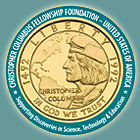
National Gallery for America's Young Inventors
1999 Inductees
Richard J. Barton, Age 19 - Lapotron,
Submersible Digital Lap Counter/Timer for Swimmers
This device was designed for use by people who swim laps in a pool. The Lapotron
automatically counts laps and times and displays this data for underwater swimmers.
This device is especially useful for swim team competitors.
Joseph Heremans, Age 17 - Thermoelectric
Relative Humidity Meter
This humidity meter is a vast improvement over the conventional chilled-mirror
dew point meter because it measures directly the relative humidity of the air,
and not merely the temperature at which the water vapor condenses. The measurement
of relative humidity serves as a powerful tool for short-term weather prediction.
Jeffrey S. Martzall, Age 17 - Two-Dimensional
Audio Tracking for Aviation Guidance Systems
The Audio Tracking System is an efficient angular and amplitude-based tracking
system. Unlike most tracking systems, which use phase and time difference between
two or more arrays of microphones, this device works on the principal that
if one changes the angle of a microphone, one will get a different amplitude
of output. In other words, one can change the sound that the tracking system
listens to, thus eliminating echoes and other unwanted sounds.
Austin S. Meggitt, Age 11 - Glove
and Battie Caddie
The Glove and Battie Caddie is a carrier that mounts to the handlebars of a
bicycle, and is designed to transport a bat, baseball glove and ball. This
allows a bicycle rider to carry these objects safely without loss of control.
Joseph Schuh, Age 19 - Universal Self-Contained
Fiber Optic SensorNetwork
This device is capable of running many different sensors on a single duplex
(double) fiber optic cable. The unique aspect of this application is that a
multitude of sensors could be placed along the fiber optic cable which require
no external power supply, diminishing the hazards and problems associated with
external power. Each of these sensors derives its power from the light traveling
within the fiber optic, using photoreactive materials (like solar cells to
power the senor), and transmits information back to a central processing unit
by modulating the light signal within the fiber optic as the carrier of data.
Alexander Wissner-Gross, Age 17 -
Fullerene-Based Nanofabrication System
This is a novel process for the macroscopic control of extended nanoscopic
fullerene structures. Since 1959, scientists have worked to realize a nanometer-scale
technology for the fabrication and application of devices and material made
to atomic specifications. Through an original computer simulation, Alexander
designed, wrote and successfully tested a novel process for the rapid construction
of such nanocomponents through the application of the physics phenomenon known
as patterned granular motion.
|

